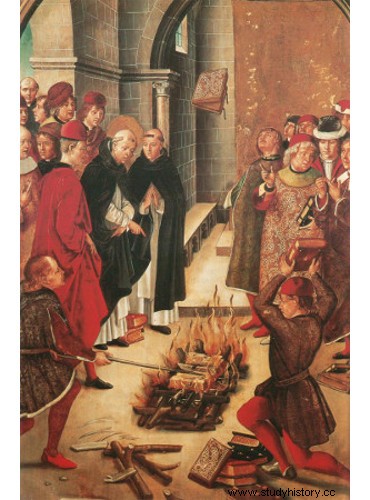
The Counter-Reform was a movement of reaction of the Catholic Church to the emergence of new Christian doctrines in Europe, in a process known as the Protestant Reformation. After losing religious, economic and political power in the German kingdoms and England, in addition to decreasing influence in the Netherlands, France, Austria, Bohemia and Hungary, the Catholic Church reacted, and in a repressive way.
One of the first measures was the creation of the Companhia de Jesus . Religious order of the Jesuits, the Society of Jesus was founded by the military Ignatius of Loyola and was organized like an army. The hierarchical structure was rigidly respected, with the superior of the order and the pope at the top.
The main function of the order was to seek the strengthening of the Church through disciplinary and moralizing actions. The Jesuits they were from then on one of the main promoters of Catholic doctrine, mainly due to the role of educators played by them.
Between 1545 and 1563 the Council of Trent was held , in Italy. This meeting of the main Catholic authorities (and also some Protestant theologians) aimed to redefine the position of the Church in relation to its religious doctrine, as well as to find ways to stop the advance of Protestantism in Europe.
Among the measures taken at the Council of Trent, there was a retreat from the criticisms of Protestants:the sale of indulgences was prohibited and it was also decided to create seminaries. This last institution would be responsible for the ecclesiastical formation of the clergy, seeking to avoid, in this way, the sale of positions in the Church.
On the other hand, what happened was the affirmation of Catholic religious dogmas. The principle of salvation by faith and good works was maintained, even after the criticisms of Martin Luther. The cult of the Virgin Mary and the saints was reaffirmed, as well as the existence of purgatory. Catholic belief would maintain the two origins:the Bible and the traditions handed down by the Catholic Church.
The constitution of a catechism to indoctrinate children was also among the measures adopted. The infallibility of the pope, that is, the notion that the pope was infallible in religious and moral matters, was reinforced, as was the dogma of transubstantiation, through which bread and wine were believed to change into body and blood. of Christ.
The Court of the Holy Office , the Inquisition , was reactivated in order to persecute practitioners of Protestant Christian doctrines. Thousands of people were tortured and many killed. Great exponents of world science, such as Galileo Galilei, were judged as heretics as a result of their research, such as the Earth revolving around the Sun. Galileo was forced to deny his own ideas to escape death at the stake.
A list of prohibited books was created, at a time when the press created by Gutenberg had facilitated the spread of written culture. The Index Librorum Prohibitorum indicated the books that were forbidden to Catholics, such as The Praise of Madness , by Erasmus of Rotterdam; the Decameron , by Boccaccio; works by Machiavelli, Newton, Copernicus, as well as Lutheran and Calvinist books. The Index it was constantly updated and went extinct just four centuries later, in 1966.
With the Counter-Reformation, the Catholic Church managed to contain the advance of Protestantism in some countries, mainly in Italy, Spain and Portugal. The fact that these last two countries undertook the Great Navigations and colonized America made most of the new continent Christianized, giving new impetus to Catholicism. The Jesuits were the main subjects of this Christianization, which included the struggle against indigenous culture, the exploitation of their work and also the death of thousands of inhabitants of the New World.
